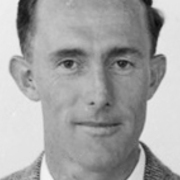
John Feeney
After wartime service in the Navy and a period as a clerical assistant in the Navy Department, John Feeney joined the National Film Unit in 1948. He put his writing skills to use as a production assistant working on the Weekly Review series, and was soon learning directing and editing skills.
The first film he is known to have worked on was Hutt Valley ... New School for Taita, an item in Weekly Review No. 376 (1948). His first screen credit was for editing and writing the commentary of the single-subject reel Weekly Review No. 417 - New Golden Hind Sails North (1949). He worked on about 20 other Weekly Review items including directing Weekly Review No. 447 - Naval Force 75 (1950). By this time the NFU had dropped the practice of including on-screen credits.
When production of Weekly Review was stopped, and the new government required the NFU to give more attention to the film requirements of government departments, Feeney worked on departmental information films promoting soil conservation and traffic safety. One of the latter, Pedestrians or Jaywalkers? (1952), got its message across with effective use of humour.
Freed from the pressure to deliver a weekly reel, Feeney was able to turn his attention to documentary, and embarked on a film that followed the course of the Wanganui River from its source to the sea. By skilfully introducing the romantic Māori legend of how the river was formed The Legend of the Wanganui River (1952) set itself apart from simply promoting scenic attractions to tourists, and met with critical and popular success.
Three documentaries that followed further enhanced Feeney’s status as a film maker – Kotuku (1954) filmed at the nesting-place of the white herons at Okarito, Pumicelands (1954) dealing with the reclaiming of wastelands for farming in the central North Island, and Hot Earth (1955) again using Māori legend to tell of the thermal wonders around Rotorua and Taupō.
Kotuku was fittingly first screened at a Royal Command Cinema Performance in Christchurch, the Queen herself having earlier been welcomed at Rotorua as “the rare white heron of a single flight”.
Pumicelands, considered by many as his finest film for the NFU, was released in NZ as Pictorial Parade No. 23, filling a gap in the monthly release schedule disrupted by demands of filming the royal visit. For an earlier contribution to the Pictorial Parade magazine-film series he had renewed his acquaintance with the navy to make the item Charting the Sea - H.M.N.Z.S. Lachlan, which he wrote, directed and edited. It was released in Pictorial Parade No. 14 (1953).
Hot Earth was completed just before Feeney’s departure for France, having received a bursary to study film production during the 1954-55 academic year. Arrangements had been made for him to visit the National Film Board of Canada before beginning his studies, and while there he made Hidden Power, a film on the development of atomic power. This film screened at the Edinburgh Film Festival in 1955 along with Pumicelands and Hot Earth, and led to his being offered a position at the NFBC on completion of his studies. His job at the NFU had been held open for him, but was less attractive than the Canadian position which better acknowledged and rewarded his talent.
Much of his time in Canada was spent in the frozen north making films about the life and legends of the people living there. Two films about Inuit artists that he wrote and directed, were nominated for Academy Awards – The Living Stone in the Documentary (Short Subject) category of the 1959 Academy Awards, and Eskimo Artist: Kenojuak in the same category in 1965. Eskimo Artist took away the best short award at that year's Bafta ceremony.
In 1964 Feeney swapped polar ice for desert heat, travelling to Egypt with the intention of capturing on film the last flood of the river Nile. He stayed on for the next 40 years, filming and photographing the landscape and the ancient monuments alongside the great river.
On retirement John Feeney returned to New Zealand, where he died on 6 December, 2006, aged 84.
Writing and original research by Clive Sowry; published on 26 July 2013
Sources include
Diana Dekker. ‘Film-maker headed overseas’ – The Dominion Post, 28 December 2006, page B3
Maurice Shadbolt, ‘John Feeney and the National Film Unit’ – Landfall 47, September 1958 (Volume 12 number 3), page 226
Unknown Writer, ‘Exodus Overseas shows “No Film Future” in New Zealand’ – The NZ Herald, 9 February 1957, page 20
Unknown Writer, ‘Canadian Film Post For Wellington Man’ – The Evening Post, 12 October 1955, page 13
Unknown Writer, ‘To Study in France’ – The Dominion, 12 June 1954, page 14
Unknown Writer, ‘Most Fitting Film For Command Programme’ – New Zealand Free Lance, 10 February 1954, page 34